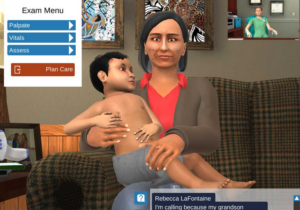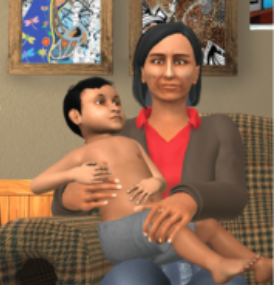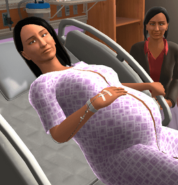Zachary LaFontaine Treatment Plan Shadow health
 Primary Diagnosis: Encounter for Routine Child Health Exam with Abnormal Findings
Primary Diagnosis: Encounter for Routine Child Health Exam with Abnormal Findings
Diagnosis: Feeding Difficulty and Nutritional Concerns
Plan of Care for Zachary: Key Interventions
Primary Diagnosis: Encounter for Routine Child Health Exam with Abnormal Findings
The primary reason for Zachary’s visit is a well-child checkup. During this routine child health exam, abnormal findings were identified, particularly related to feeding difficulties. The primary diagnosis ensures that Zachary’s visit is properly coded and covered by insurance, as it represents the overall reason for the visit.
Diagnosis: Feeding Difficulty
Zachary’s feeding difficulties are a major concern. Evidence of feeding challenges includes:

Struggling to meet your deadline?
Get your assignment on Zachary LaFontaine Treatment Plan Shadow health done by certified MDs and PhDs in the USA. ORDER NOW!
- Breasts not feeling empty after feeding
- Zachary falling asleep during feedings
- Feeding sessions being too short or insufficient in length
- A drop in weight percentile for his age
- Less frequent than normal elimination patterns
- The mother perceiving that she doesn’t have enough time to feed
These signs point to feeding issues, potentially caused by problems with latching or inadequate milk supply. Short feeding sessions and insufficient nutrition may also be due to the mother not consuming enough calories, which can further impact Zachary’s weight gain and overall nutrition.
Plan of Care:
- Vitamin D Supplementation and Infant Nutrition
Zachary may be at risk for Vitamin D deficiency, as breast milk lacks sufficient Vitamin D. It is recommended to provide Vitamin D supplementation for infants, which is important for bone and tooth development. This will be an essential part of his nutrition plan.
- Referral to Lactation Specialist for Feeding Support
Since Zachary is experiencing feeding difficulties, a referral to a lactation consultant is necessary. A lactation specialist can help the mother address feeding issues, improve her milk supply, and offer guidance on effective breastfeeding techniques, which will help improve Zachary’s nutritional intake. - Managing Feeding Difficulties in Infants: Best Practices for Pediatric Care
Feeding difficulties, such as inadequate feeding duration and inefficient latch, can interfere with an infant’s ability to gain weight and meet developmental milestones. Addressing these challenges through a structured feeding schedule, lactation consultation, and use of breast pumps is critical to ensuring Zachary’s proper growth and development. - Breastfeeding Education: Supporting New Mothers for Successful Feeding
Education on breastfeeding techniques and the nutritional needs of breastfeeding mothers is crucial. Providing support to the mother can help her understand the importance of nutrition, caloric intake, and how her health affects Zachary’s ability to feed effectively. Breastfeeding support programs and lactation consultation are recommended to improve feeding practices and alleviate stress for the mother. - Scheduled Follow-ups and Ongoing Care for Infant Development
Follow-up care is vital to track Zachary’s progress in addressing feeding difficulties and monitoring his growth and weight gain. A follow-up appointment will be scheduled in two months to reassess his feeding progress, ensure proper development, and address any ongoing concerns.
Preventive Screenings and Interventions:
At Zachary’s age, routine pediatric health assessments should include the administration of vaccines like Hepatitis B, Rotavirus, Diphtheria, Tetanus, Pertussis, Pneumococcal, Poliovirus, and Haemophilus influenzae. These immunizations are essential for his long-term health and well-being. A discussion will be held with the mother about the importance of these vaccinations, and they will be administered with her consent.
Nutritional Guidelines for Infants with Feeding Issues:
For infants like Zachary who are facing feeding difficulties, it is crucial to adhere to infant nutrition guidelines. This includes ensuring an adequate intake of calories, proper feeding frequency, and weight gain monitoring. Structured feedings, either through breastfeeding or formula supplementation, should be encouraged to ensure Zachary receives enough nutrients for optimal growth. 
Referral to Lactation Specialist:
As part of Zachary’s care plan, a referral to a lactation consultant is necessary. The lactation specialist can assist in resolving issues such as low milk supply, improper latch, or insufficient feeding sessions, which are contributing to Zachary’s feeding difficulties. Early intervention can support both Zachary’s nutritional needs and the mother’s confidence in breastfeeding.
Follow-up Care and Preventive Screenings:
Scheduled follow-up visits are essential for monitoring Zachary’s development and ensuring that his feeding difficulties are resolved. These visits will also allow for the ongoing tracking of his nutritional needs and development. Preventive health checks, including immunizations and developmental screenings, will be integrated into his ongoing pediatric care plan.
This treatment plan for Zachary LaFontaine addresses both immediate and long-term care needs, focusing on feeding issues, nutrition, and preventive health practices.
Zachary LaFontaine Treatment Plan Shadow health
Primary Diagnosis: Review your answers for the Problem Selection activities. You receive one point for each correct diagnosis, and one point for each correct evidence linked to a correct diagnosis. If there are multiple correct diagnoses, you will also receive a point for correctly selecting which diagnosis is the primary diagnosis.
| Learner Selection | Model Documentation |
|
Diagnosis: Encounter for routine child health examination with abnormal findings Identified as primary Evidences: Ms. LaFontaine reports that the reason for the visit is a well-child exam Learner Rationale: nothing Score: 2 out of 3 |
Diagnosis: Encounter for routine child health examination with abnormal findings Primary: Yes Evidences: Ms. LaFontaine reports that the reason for the visit is a well-child exam Model Rationale: The primary diagnosis is the reason for the patient’s visit. Because Ms. LaFontaine has indicated she has brought Zachary in for his well-child exam, the correct primary diagnosis is “Encounter for routine child health examination with abnormal findings.” As a primary care provider, it is critical to properly code the reason for Zachary’s visit so it can be covered by insurance. |
Additional Diagnosis
| Learner Selection | Model Documentation |
|
Diagnosis: Feeding Difficulty Evidences: Breasts are not always empty after feeding Falling asleep while breastfeeding Feeding sessions of insufficient length Mother does not perceive enough time to feed Mother does not consume enough calories Learner Rationale: I really found a normal developed infant Score: 4 out of 6 |
Diagnosis: Feeding Difficulty Evidences: Breasts are not always empty after feeding Drop in weight percentile for age Feeding sessions of insufficient length Less frequent than normal elimination Mother does not perceive enough time to feed Model Rationale: A delay or reduction in developmentally appropriate weight gain indicates that Zachary has a problem related to feeding, nutrition, or digestion, as does his somewhat infrequent eliminations. Daanis reports that her breasts do not always feel empty after feedings, which could be an indication that Zachary is experiencing mechanical problems with latching or that Daanis cannot express breast milk. However, Daanis also reports that she does not feel like she has enough time to feed Zachary, and describes feeding sessions that are shorter than recommended. This leads to “Feeding difficulty” being the correct additional diagnosis. Kerzner B et al. (2015). A practical approach to classifying and managing feeding difficulties. Pediatrics, 135(2): 344. |
 Plan of Care
Plan of CareReview your answers for the Plan of Care activity. You must select “Yes” or “No” for each of the seven care actions. You will receive one point for determining the correct answer for each care action.
| Learner Selection | Model Documentation |
|
Pharmacological Intervention
Selected: No Learner Rationale: No for the infant. In the other hand, the mother will need suplements such as multivitamis Score: 0 out of 1 |
Recommended: Yes
Zachary may be deficient in Vitamin D, which is critical for infant bone and tooth development. Vitamin D deficiency is common in children who are breastfed, as breast milk contains no Vitamin D. You will recommend an OTC Vitamin D supplement to Daanis for Zachary to take. |
|
Non-Pharmacological Intervention
Selected: Yes Learner Rationale: Infant nutrition, and breast feeding education. Score: 1 out of 1 |
Recommended: Yes
You will talk to Daanis about acquiring a breast pump and planning an effective feeding schedule. A more structured feeding schedule and the use of a breast pump will allow Daanis to fully meet Zachary’s nutritional needs while also maintaining her own well being. |
|
Educate Guardian
Selected: Yes Learner Rationale: as above Score: 1 out of 1 |
Recommended: Yes
Providing education to patients’ guardians is a key component of pediatric practice. Clearly communicating to guardians what care their children need and why improves adherence and outcomes. |
|
Preventive Screening and Intervention
Selected: No Learner Rationale: not need it Score: 0 out of 1 |
Recommended: Yes
At two months, Zachary is due for several vaccines: Hepatitis B (HepB), Rotavirus (RV), Diphtheria, Tetanus and Acellular pertussis (DTaP), Pneumococcal conjugate (PCV13), Inactivated poliovirus (IPV), and Haemophilus influenzae (HiB). You will talk to Daanis about the need for these vaccines and administer them with her consent. |
|
Diagnostic Testing: Labs and Imaging
Selected: No Learner Rationale: not need it Score: 1 out of 1 |
Recommended: No
As the patient’s diagnosis is evident, no further diagnostic testing is needed. |
|
Referral of Care
Selected: Yes Learner Rationale: Breastfeeding education. Mother health, caloric intake, supplements or vitamis use. Score: 1 out of 1 |
Recommended: Yes
A lactation specialist will allow Daanis to improve her feeding practices and integrate her challenging schedule with Zachary’s nutritional and emotional needs. You will refer Daanis to a lactation specialist that is in network with Indian Health Services. |
|
Continued Care and Follow-up
Selected: Yes Learner Rationale: in 2 months of before if needed. Score: 1 out of 1 |
Recommended: Yes
Because Zachary is lagging developmentally, it would not be appropriate to wait for his four-month wellness visit to see if the interventions you have selected are working. You will schedule a follow-up appointment with Daanis to make sure that the interventions have resolved Zachary’s feeding problems and that he is gaining weight in a developmentally appropriate way. |
Zachary LaFontaine Objective Data
Objective Data Collection: 24.33 out of 25 (97.32%)

Dont wait until the last minute.
Provide your requirements and let our native nursing writers deliver your assignments ASAP.


